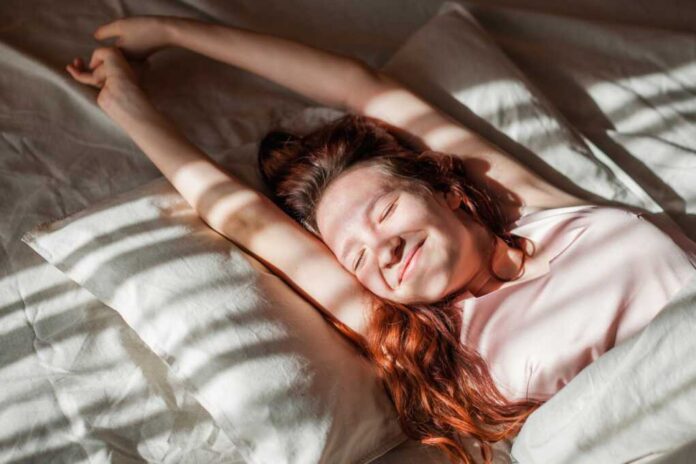
Millions of Americans are seeking innovative ‘sleepmaxxing’ strategies to combat widespread sleep problems that affect their health, productivity, and overall quality of life.
At a Glance
- One in three Americans struggles with falling asleep due to factors like chronic pain, nicotine use, hormonal changes, and mental health issues
- Creating a sleep-friendly environment involves keeping the room cool (60-67°F), dark, and quiet, potentially using white or brown noise
- Establish a consistent bedtime routine, avoiding screens 1-2 hours before sleep and eating 3-4 hours before bedtime
- Mindfulness practices like the 4-7-8 breathing technique, meditation, and gratitude journaling can significantly improve sleep quality
- Regular exercise, proper light exposure, and avoiding caffeine and alcohol before bed are crucial lifestyle factors for better sleep
Understanding the Sleep Crisis
The sleep deprivation epidemic in America has reached alarming proportions, with millions struggling to get adequate rest each night. Sleep issues don’t just cause fatigue – they significantly impact physical health, cognitive function, emotional regulation, and productivity. Poor sleep increases risks for serious conditions including heart disease, diabetes, obesity, and depression, making it a major public health concern. For adults over 40, sleep problems often intensify due to aging-related changes in sleep architecture, increased likelihood of chronic conditions, and hormonal shifts.
Modern lifestyle factors contributing to poor sleep include excessive screen time, irregular schedules, work-related stress, and environmental factors. The National Institutes of Health recommends at least seven hours of quality sleep nightly, yet many Americans consistently fall short of this target. Recognizing sleep as a fundamental health pillar rather than a luxury has led to increasing interest in evidence-based “sleepmaxxing” techniques designed to optimize rest and recovery.
Creating the Optimal Sleep Environment
The physical environment dramatically impacts sleep quality. Temperature regulation stands as one of the most critical factors, with experts recommending keeping bedrooms between 60-67°F (15.6-19.4°C). This cooler range helps facilitate the natural drop in body temperature that occurs during sleep. Light control is equally important – even small amounts of artificial light can suppress melatonin production and disrupt circadian rhythms. Using blackout curtains, eliminating electronic lights, and avoiding screen exposure before bed can significantly improve sleep onset and quality.
Noise management through sound machines, earplugs, or specialized audio like brown or pink noise can mask disruptive sounds. The comfort of your sleep surface matters tremendously – investing in appropriate mattresses, pillows, and bedding that support your specific sleep position and physical needs pays dividends in sleep quality. Additionally, reserving your bedroom exclusively for sleep and intimacy helps train your brain to associate the space with rest rather than wakefulness or stimulation.
Developing an Effective Sleep Routine
Consistency forms the cornerstone of healthy sleep. Maintaining regular sleep and wake times – even on weekends – helps regulate your body’s internal clock. A deliberate wind-down routine signals to your brain that it’s time to transition to sleep. Experts recommend dimming lights 60-90 minutes before bedtime to allow natural melatonin production. This period should exclude stimulating activities, work-related tasks, or emotionally charged conversations that might elevate stress hormones.
Digital detox before bed is essential, as blue light from screens suppresses melatonin and the content itself can be mentally stimulating. Replace scrolling with calming activities like reading physical books, gentle stretching, warm baths or showers, or relaxation practices. Body temperature naturally decreases during sleep, so a warm bath 1-2 hours before bed can enhance this drop when you exit the water, making falling asleep easier. Establishing these consistent patterns helps your body recognize sleep cues and respond accordingly.
Mindfulness and Relaxation Techniques
Mental activity significantly impacts sleep quality, with racing thoughts and anxiety being primary causes of insomnia. Structured breathing exercises like the 4-7-8 technique (inhale for 4 counts, hold for 7, exhale for 8) activate the parasympathetic nervous system, reducing stress hormones and preparing the body for rest. Progressive muscle relaxation, where you systematically tense and release muscle groups, helps release physical tension that might otherwise prevent sleep.
Gratitude journaling before bed shifts focus from worries to positive aspects of life, promoting emotional well-being and reducing rumination. Studies show that writing down concerns can help “download” them from active mental processing. Guided sleep meditations provide structured mental focus, drawing attention away from busy thoughts toward restful awareness. For those who struggle with traditional meditation, body scan techniques offer an accessible alternative, systematically directing attention throughout the body to identify and release tension.
Lifestyle Factors Affecting Sleep Quality
Daily habits significantly influence nighttime rest. Regular physical activity improves sleep quality and duration by reducing stress hormones and promoting deeper sleep stages. However, timing matters – exercise elevates core body temperature and stimulates the nervous system, so completing workouts at least 3-4 hours before bedtime is ideal. Nutrition plays a crucial role, with heavy or spicy meals before bed potentially causing discomfort or acid reflux. Instead, small, nutrient-dense evening snacks containing tryptophan, magnesium, or melatonin may support sleep biochemistry.
Caffeine’s half-life of up to 6 hours means afternoon consumption can disrupt evening sleep, while alcohol, though initially sedating, fragments sleep architecture and reduces restorative REM sleep. Light exposure management throughout the day enhances circadian rhythm function – bright morning light signals wakefulness while reducing blue light exposure in evenings prepares the body for sleep. Managing daytime stressors through techniques like time-blocking, delegation, and mindfulness creates mental space for better sleep. For those with persistent sleep issues, tracking patterns through sleep diaries or wearable devices can identify specific factors disrupting rest.
Sources:
https://www.cnet.com/health/sleep/an-expert-weighs-in-on-the-10-most-popular-sleep-hacks/
https://www.goodhousekeeping.com/health/wellness/a63493513/things-successful-people-do-before-bed/


















